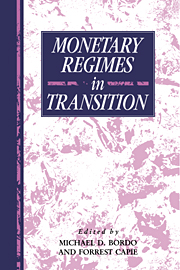Book contents
- Frontmatter
- Contents
- List of figures
- List of tables
- List of contributors
- 1 Introduction
- Part I Commodity money standards in transition
- Part II Successful and unsuccessful adherence to the gold standard
- Part III Wartime upheaval and postwar stabilization
- 8 British and French finance during the Napoleonic Wars
- 9 Interpreting a change in monetary policy regimes: a reappraisal of the first Hungarian hyperinflation and stabilization, 1921–28
- 10 Halting inflation in Italy and France after the Second World War
- 11 The rise and fall of credit controls: the case of Sweden, 1939–89
- Part IV Perspectives on monetary regimes
- Index
10 - Halting inflation in Italy and France after the Second World War
Published online by Cambridge University Press: 05 May 2010
- Frontmatter
- Contents
- List of figures
- List of tables
- List of contributors
- 1 Introduction
- Part I Commodity money standards in transition
- Part II Successful and unsuccessful adherence to the gold standard
- Part III Wartime upheaval and postwar stabilization
- 8 British and French finance during the Napoleonic Wars
- 9 Interpreting a change in monetary policy regimes: a reappraisal of the first Hungarian hyperinflation and stabilization, 1921–28
- 10 Halting inflation in Italy and France after the Second World War
- 11 The rise and fall of credit controls: the case of Sweden, 1939–89
- Part IV Perspectives on monetary regimes
- Index
Summary
Introduction
In the aftermath of the Second World War, Italy and France like the other European belligerents experienced persistent, rapid, disruptive inflations. Within four years of the armistice, however, both countries had succeeded in bringing the era of postwar inflation to a close. This chapter is an attempt to understand what made their stabilizations possible.
Doing so is no easy task. There is an abundance of potential explanations for the two stabilizations: fiscal correction (tax increases and expenditure reductions), monetary restriction (reserve requirements and credit controls), changes in domestic politics (the exclusion of the Communists from postwar governments), and foreign aid (notably the Marshall Plan).
The challenge is not to formulate hypotheses, but to reject them. This is analogous to the problem faced by players of the board game “Clue,” whose object is to determine who committed the murder in which room using what weapon. Players roll dice and draw cards to eliminate suspects until only one person, room, and weapon remain.
In this chapter we utilize international comparisons in place of dice and cards. Comparisons discipline the argument. Although many of the explanatory factors we consider appeared simultaneously in Italy and France, the two countries stabilized at very different times (Italy in the summer of 1947, France at the end of 1948). Given the difference in timing, either events that occurred simultaneously in the two countries cannot account for both stabilizations, or else other critically important differences across countries determined the lag with which those events brought inflation to a halt.
- Type
- Chapter
- Information
- Monetary Regimes in Transition , pp. 312 - 345Publisher: Cambridge University PressPrint publication year: 1993
- 46
- Cited by



